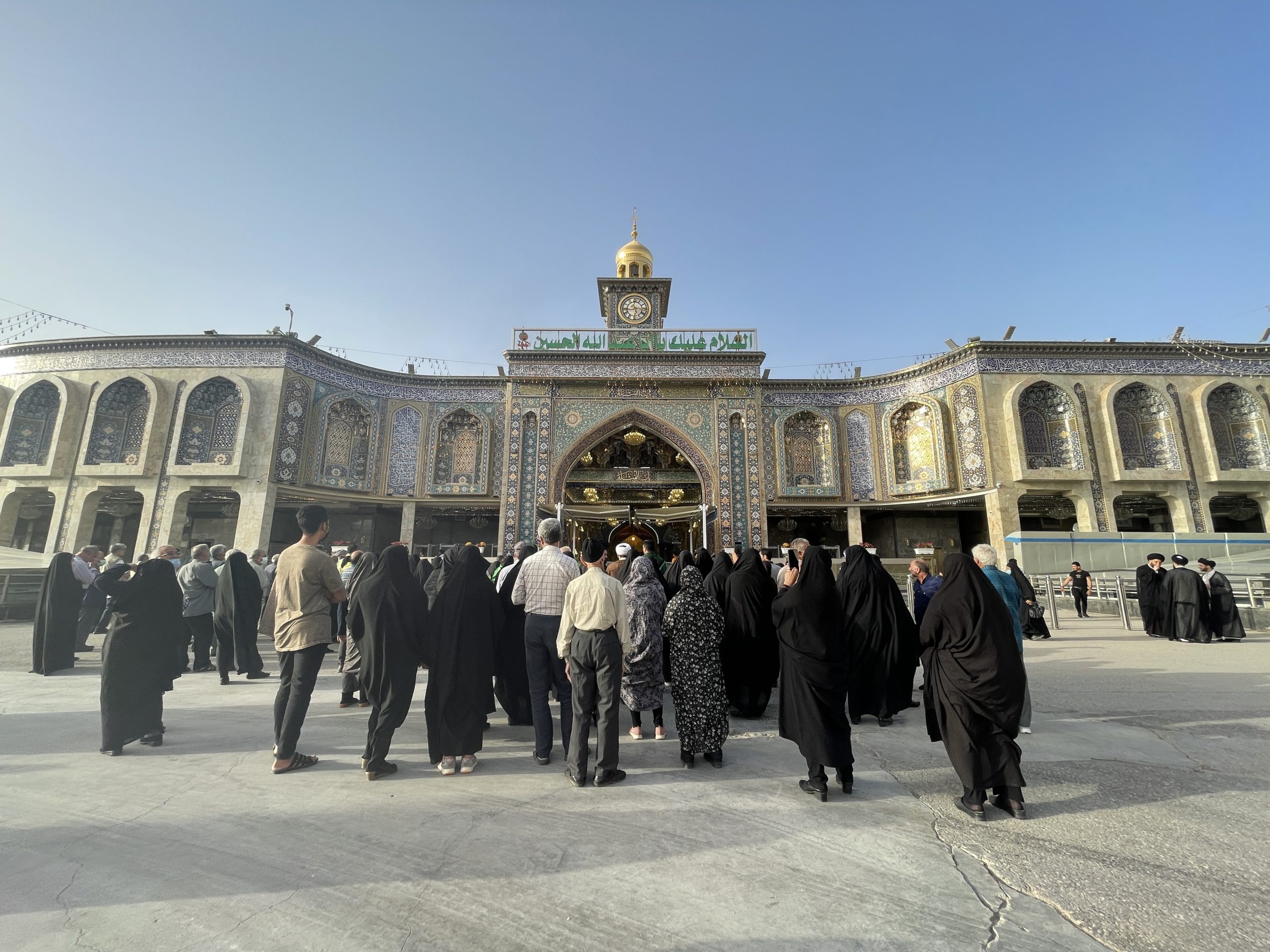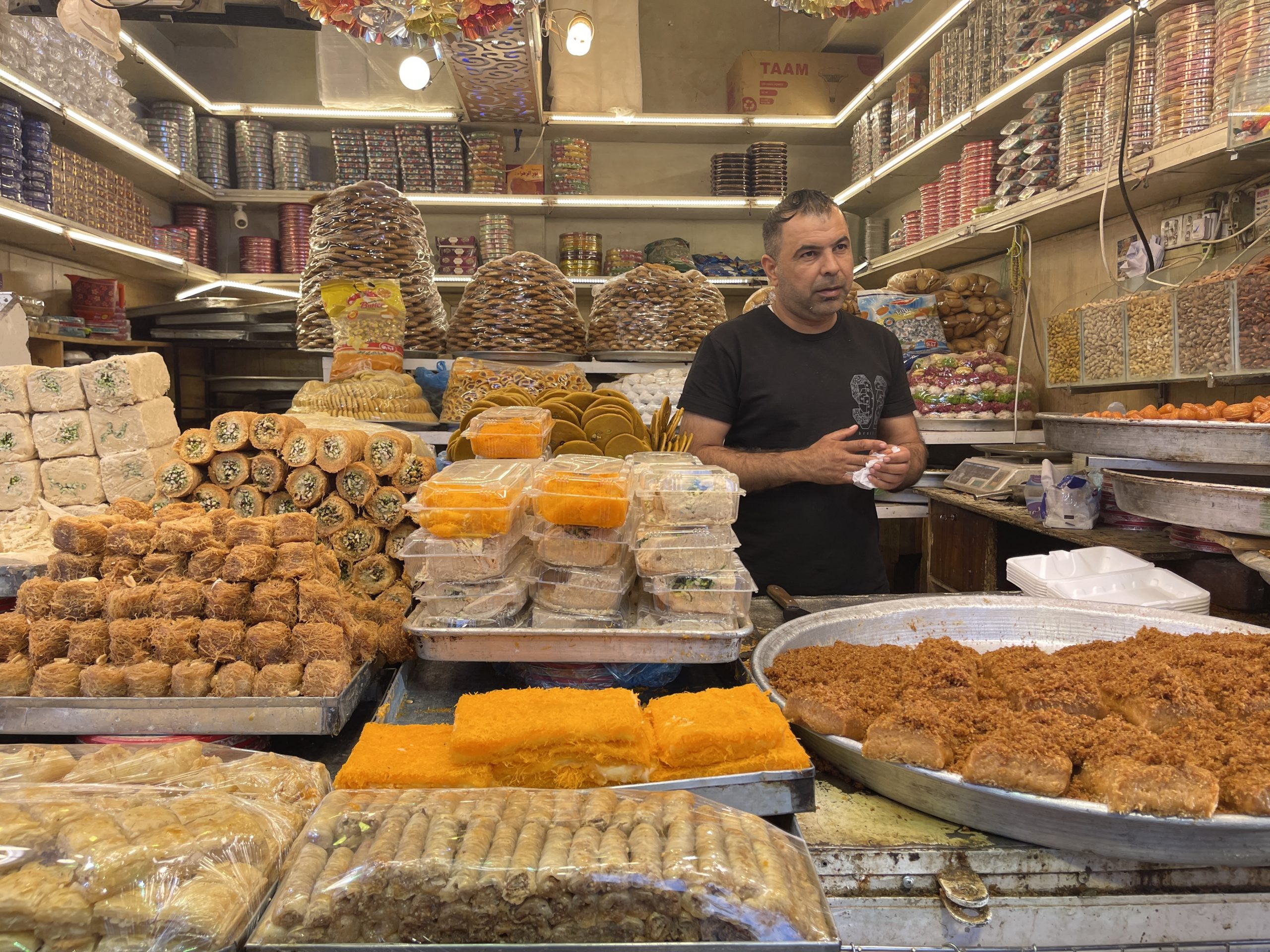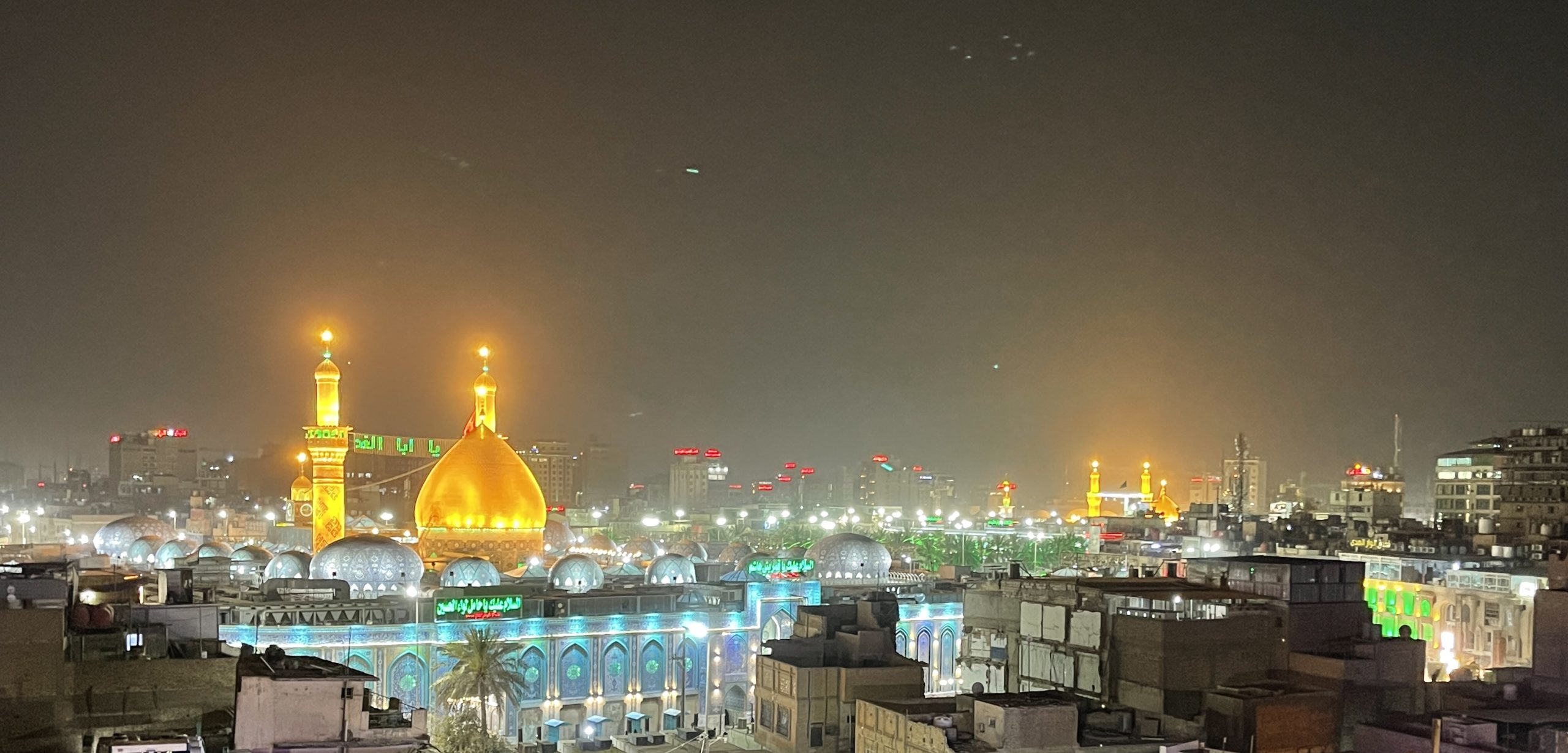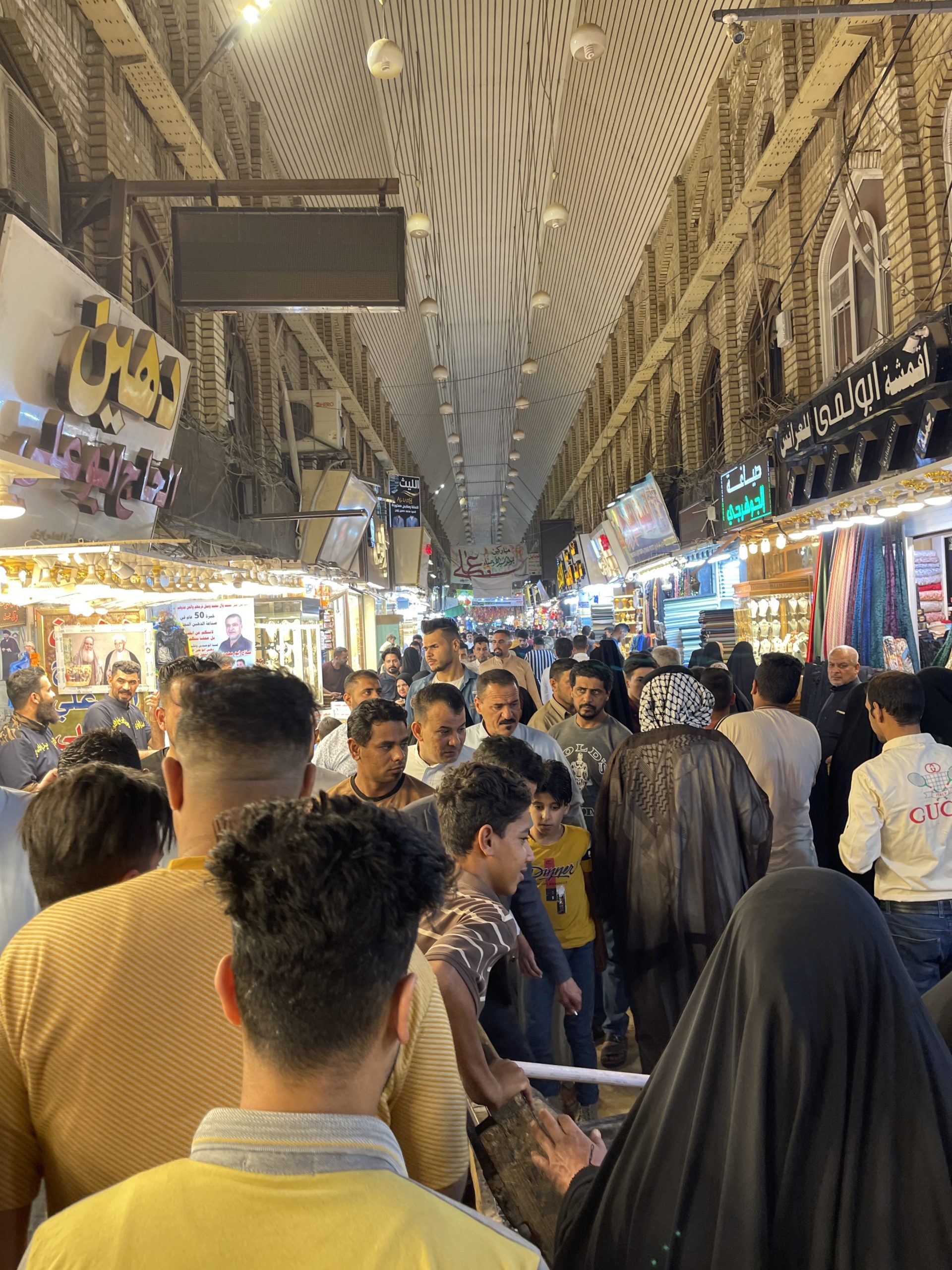Baghdad’s last supper
We went traditional on our last night in Baghdad and went for river fish (mazgouf) at Abu Nawas. The fish is cut in half and then barbecued and served with bread and vegetables. One fish was enough for three – delicious. Then we wandered back the 3km through town. Evening is the best time to enjoy Baghdad. It’s cool, shops are open, people are out, (and in Ramadan they have eaten so are feeling better). You also can’t see all the rubbish. The street vibe is fun, and the local guys are like strutting cocks with their very tight skinny jeans, fake Versace T-shirt’s and well coiffed rockabilly hairstyles (I was too shy to get photos but they were incredible). We stopped at a shop making home made semsmieh (sesame sweets) – the shopkeeper gave us a spoon to try the paste direct from the grinder – unbelievably good. We bought some with pistachio and cardamom and then went to the Iraqi version of starbucks to have it with tea.








Al Ukhaider fortress – the full Iraqi experience
We planned to visit the Al Ukhaider fortress and been warned that the security checkpoint could be ‘problematic’. We arrived at about 10.15 after leaving Baghdad at 8, and then proceeded to wait in the car for about an hour while a variety of moustached men deliberated with Hussein over our passports and our intentions. After much teeth sucking it was decreed we had to go to Karbala to get a permit to visit the fort. Off to Karbala we went, but before we arrived we were stopped at another checkpoint for another interrogation for patient Hussein for a further 30 mins. By the time we got to Karbala it was close 1pm, we were hot, tired and hungry and the phone calls Hussein made it evident that no permit would be forthcoming, so instead we headed to the hotel. We didn’t get to see the fort, but we did get an entirely Iraqi experience. The locals are habituated to the constant security posts, but it helps me appreciate the joy of living in a country where you don’t have to prove your identity and have freedom of movement.
Kerbala – The incredible shrines of Hussain and Abbas
Kerbala is home to the two neighbouring shrines of Hussain ibn Ali (son of Imam Ali) and Abbas (Hussain’s half brother). These two were martyred in one of the pivotal moments of Shia history and now the site is an incredibly holy place for Shia pilgrims worldwide. Together with Najaf, these cities are the most conservative in Iraq and I wore a full Iraqi chador for the duration – and didn’t see a single western looking person. The upside was that I blended in seamlessly when my mouth was shut and I could take excellent pictures
We first visited the Abbas shrine and after my fourth pat down of the day, I was allowed to look around the men’s area with Steph and Hussain. The pictures don’t do it justice – it’s a remarkable building with enormous amounts of gold. The women’s side of the shrine was a bit like a mosh pit. Shia women don’t mind getting up close and personal, and while they aren’t aggressive they will gently shift you out of the way, and they are not bothered about personal space (in a queue the woman behind you will inevitably be squeezed up against you and nudge you into the person in front)
We next went to the Hussain mosque which was even busier. I got evicted from the men’s area but did manage to go back in to the gift shop. I was fascinated by the small rounds of stone which people placed their heads on to pray. There were multiple available to borrow, and I was tempted to borrow one permanently but would feel too guilty. We went to the gift shop to buy one and it turns out they give them away – one for each visitor. The best thing about this shrine was that the dome retracted like the roof on Wimbledon





























Iftar between the shrines
It was an hour before iftar and we did see dinner being set up for a free iftar but it was segregated into a mans group and a woman’s group with very looooong queues. So we decided to buy food and strategically place ourselves next to neighbours with good home cooked food who we could swap food with. There were hundreds of people with their blankets occupying the large marble walkway between the shrines. We bought a whole roast chicken, rice, bread, pickled vegetables and some excellent local sweets made from tahini and coconut, and procured a suitable piece of plastic to sit on. Our neighbours were delightful and they let me cuddle their cute baby while we waited for sunset. They gave us some excellent stuffed dolmas and pickles, so we gave them a lot of sweets. The men next door gave us Briyani and we gave them chicken. The other side gave us dates and laban (the salty yogurt drink) It was really fun – I can’t imagine doing this anywhere else (except perhaps Iran :-)). After an excellent dinner we strolled around town and checked out the shops. We tried to stop twice for shisha but neither place would let a woman in .
One note – get someone to help you put the chador on – my guide, driver and husband were all entirely useless at helping me figure it out, but an Iraqi-American lady in my hotel helped me with mine. Also, I told everyone that Iraq was not dangerous – I stand corrected – walking in a chador/iraqi abbaya is bloody hard and I tripped several times. Sitting down was even worse as I kept sitting on the wrong bit of fabric and yanking my head sideways – it takes some practice (but my efforts were entertaining to passers by)





















By the Rivers of Babylon …
Babylon the great, mother of harlots and the abominations of the earth (revelations). Home to Hammurapi and Nebuchadnezzar, the mythical hanging gardens and the tower of Babel. We had arrived at sin city. Hussein played boney m ‘by the rivers of babylon’ up loud as we rolled in through the gates. Much of the original architecture was pinched by the Germans in 1904 and the original brickwork and arch can be seen at the Pergamon Museum in Berlin. Saddam also ‘reconstructed’ a lot of the site, so badly that unesco removed heritage status. There is a lot still to discover here, but not much going on to sort the archaelogical dig
The upside of Ramadan is that there are no tourists during the day, and the guards are mostly asleep. We had the site to ourselves and were surprised as we wandered around the ruins how many broken bits of tablet were lying around with original cuneiform writing (the first form of writing invented by the Iraqis). It was fascinating that Nebuchadnezzar was so convinced of his genius that he had bricks inserted in the build with writing saying how great he was (in cuneiform in the photos). Saddam loved the idea so much he nicked it (you can see his verion in arabic, also in the photos) so there are lots of bricks proclaiming his greatness. The site was lovely and walkable, and I had to do another loud rendition of Boney M in the throne room with some dance moves (much to the amusement of the attendant who arrived half way through).












Saddam’s once used palace
Saddam built himself some impressive abodes – and his Babylon Palace must have been stunning. This one is right next to Babylon overlooking the ruins. Apparently he only visited once, and the locals thoroughly ransacked it after the war. The marble floors, chandeliers and ceiling paintings survived, as did the Stalin-esque carvings of himself. The locals have added quite a lot of graffiti.







The last Jews in Iraq
We stopped briefly in Al Kifl to see the synagogue which is now a mosque with a lovely minaret. 400 Jews used to live here at the tomb of Ezekiel. The site was lovely but honestly I was more fascinated by two camels zenly sitting in the back of a Ute




More holiness in Najaf – Imam Ali’s Shrine
Ali (fourth caliphate and son in law of the prophet) died in Najaf/Kufa, and now Najaf is the most popular place for shia muslims to get buried so they can be close to Imam Ali and his shrine. We toured the mosque – it is stunning with a gold facade and dome. But it is very hard to see how lovely the shrine is underneath all the stuff that has been added to the building – umbrellas to keep the sun off, lost property signs, loud speakers, large screen TVs, scaffolding and cranes for maintenance, and a big dose of fluorescent lighting and light strips which was reminiscent of Vegas. The beauty of the building is well hidden – but this is because the shrine is lively and used and actively serving their community purpose. I stopped trying to see around the ugly stuff and instead tried to focus on the central role of the shrine in the community – that was where the beauty lay
We had a truly wonderful iftar dinner with Hussein’s family at the shrine. His three sisters, one husband, and innumerable kids all showed up from Babylon laden down with food to meet us where we had baggsed a large bit of carpet. His mum is a clear matriarch and dispenses orders verbally, with hand signals, and occasionally with just a look and an eyebrow raise. She has seven children and has been the principal of a girls secondary school for fifteen years after many years teaching. Her iftar feast was amazing – best briyani I have ever eaten, with dumpling soup, pickles, cheese and yogurt. Followed by watermelon, fruit, amazing sesame biscuits, chocolate and tea. All bought from home in huge pots and a tea dispenser. Hussein is her favourite child (she unashamedly agreed when all the girls said it was true). They were curious about us (no, not Muslims, no, we don’t have children, yes we love iraq) and I had a fascinating chat with his youngest sister. I bottle fed the youngest baby to give her mum a break and she demolished half a bottle and was sound asleep with it five minutes in spite of the noise and bright lights. And then we sat around chatting and people watching
Hussein’s family stayed at the shrine all night. After iftar they planned to pray and shop and eat until their final morning meal then they would head home and sleep all day. In a shrine it is perfectly acceptable to have a big picnic, a nap, play with your kids and generally hang out. These are genuine community spaces where you can eat and sleep with your neighbours. Toilet facilities at are amazing – the ladies loo was an entire basement compound with 100 loos, tonnes of sinks, and I never had to wait. It was super clean with lots of attendants on site. There were free drinking water stations, lots of carpets to sit on and free storage lockers. I felt genuinely comfortable apart from not being able to stand and sit properly in the Abbaya. It’s quite lovely and hard to imagine doing the same at home – I have been to the loos at Westminster abbey and they were tiny and not flash, and I am pretty sure I can’t nap and picnic in the gardens. It was a really lovely evening – reminded me of being home on the marae. Stuffed and sleepy we headed back to the hotel after a short wander through the market.
















Getting buried with Ali and a million others
Our final stop in Najaf on our last morning was the worlds largest cemetery spanning over 900 hectares and the resting place of millions of Muslims who want to be buried close to the resting place of Ali. The site is rammed with spots sold at a premium. There seems no order to the layout. We had a wander around marvelled at the posters created to farewell loved ones. Street vendors were selling plastic flowers and large bottles of rose water to clean the tombs with










Next stop Nasariyah….
Najaf, April 15, 2022
* note this blog gets written with thumbs on an iPhone while on the road. Please forgive typos. Also note I have no view on religion, so please blame any factual inaccuracies on history and religion on the Bradt guide book and Wikipedia
Really enjoying this – thank you! Iraq’s definitely now on my “must visit” list.
Looking forward to the next update….
Thanks, it has definitely been a highlight 🙂